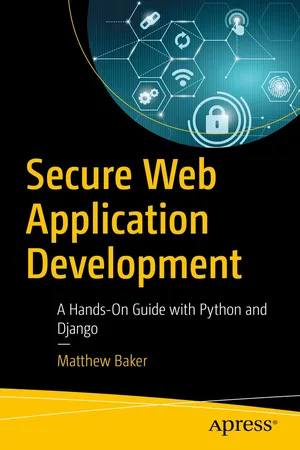
This is a test
- English
- ePUB (mobile friendly)
- Only available on web
eBook - ePub
Book details
Table of contents
Citations
About This Book
Cyberattacks are becoming more commonplace andthe Open Web Application Security Project (OWASP), estimates 94% of sites have flaws in their access control alone. Attacks evolve to work around new defenses, and defensesmust evolve to remain effective. Developers need to understand the fundamentals of attacks and defensesin order to comprehend new techniques as they become available. This book teaches you how to write secure web applications.
The focus is highlighting how hackers attack applications along with a broad arsenal of defenses. This will enable you to pick appropriate techniques to close vulnerabilities while still providing users with their needed functionality.
Topics covered include:
- A framework for deciding what needs to be protected and how strongly
- Configuring services such as databases and web servers
- Safe use of HTTP methods such as GET, POST, etc, cookies and use of HTTPS
- Safe REST APIs
- Server-side attacks and defensessuch as injection and cross-site scripting
- Client-side attacks and defensessuch as cross-site request forgery
- Security techniques such as CORS, CSP
- Password management, authentication and authorization, including OAuth2
- Best practices for dangerous operations such as password change and reset
- Use of third-party components and supply chain security (Git, CI/CD etc)
-
What You'll Learn
- Review the defensesthat can used to prevent attacks
- Model risks to better understand what to defend and how
- Choose appropriate techniques to defend against attacks
- Implement defensesin Python/Django applications
Who This Book Is For
- Developers who already know how to build web applications but need to know more about security
- Non-professional software engineers, such as scientists, who must develop web tools and want to make their algorithms available to a wider audience.
- Engineers and managers who are responsible for their product/company technical security policy
Frequently asked questions
At the moment all of our mobile-responsive ePub books are available to download via the app. Most of our PDFs are also available to download and we're working on making the final remaining ones downloadable now. Learn more here.
Both plans give you full access to the library and all of Perlego’s features. The only differences are the price and subscription period: With the annual plan you’ll save around 30% compared to 12 months on the monthly plan.
We are an online textbook subscription service, where you can get access to an entire online library for less than the price of a single book per month. With over 1 million books across 1000+ topics, we’ve got you covered! Learn more here.
Look out for the read-aloud symbol on your next book to see if you can listen to it. The read-aloud tool reads text aloud for you, highlighting the text as it is being read. You can pause it, speed it up and slow it down. Learn more here.
Yes, you can access Secure Web Application Development by Matthew Baker in PDF and/or ePUB format, as well as other popular books in Computer Science & Web Programming. We have over one million books available in our catalogue for you to explore.
Information
Table of contents
- Cover
- Front Matter
- 1. Introduction
- 2. The Hands-On Environment
- 3. Threat Modelling
- 4. Transport and Encryption
- 5. Installing and Configuring Services
- 6. APIs and Endpoints
- 7. Cookies and User Input
- 8. Cross-Site Requests
- 9. Password Management
- 10. Authentication and Authorization
- 11. OAuth2
- 12. Logging and Monitoring
- 13. Third-Party and Supply Chain Security
- 14. Further Resources
- Back Matter